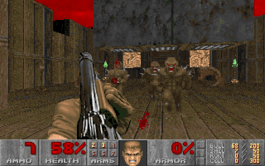Shooter game
| Part of a series on |
| Action games |
|---|
 |
|
|
Shooter games are a subgenre of action game, which often test the player's speed and reaction time. It includes many subgenres that have the commonality of focusing on the actions of the avatar using some sort of weapons. Usually this weapon is a gun or some other long-range weapon. A common resource found in many shooter games is ammunition. Most commonly, the purpose of a shooter game is to shoot opponents and proceed through missions without the player character being killed or dying. A shooting game is a genre of video game where the player has limited spatial control of his or her character, and the focus is almost entirely on the defeat of the character's enemies using long-range weaponry.
Subgenres
Shoot 'em up
Shoot 'em ups are a specific subgenre of shooters wherein the player may move up and down and left and right around the screen, typically firing straight forward.
Shoot 'em ups share common gameplay, but are often categorized by viewpoint. This includes fixed shooters on fixed screens, such as Space Invaders and Galaxian; scrolling shooters that mainly scroll in a single direction, such as Xevious and Darius; top-down shooters (sometimes referred to as twin-stick shooters) where the levels are controlled from an overhead viewpoint, such as Bosconian and Time Pilot; rail shooters where player movement is automatically guided down a fixed forward-scrolling "rail", such as Buck Rogers: Planet of Zoom and Space Harrier; and isometric shooters which use an isometric perspective, such as Zaxxon and Viewpoint. This genre also includes "run and gun" games which emphasize greater maneuvering or even jumping, such as Thexder, Contra and Metal Slug.[1][2]
Shooting gallery
Shooting gallery games include light gun games, although many can also be played using a regular joypad and an on-screen cursor to signify where the bullets are being aimed. When these debuted, they were typically played from a first-person perspective, with enemy fire that occurred anywhere on the screen damaging or killing the player. As they evolved away from the use of light guns, the player came to be represented by an on-screen avatar, usually someone on the bottom of the screen, who could move and avoid enemy attacks while returning fire. These sorts of shooters almost always utilize horizontal scrolling to the right to indicate level progression, with enemies appearing in waves from predestined locations in the background or from the sides. One of the earliest examples is the 1985 arcade game Shootout produced by Data East.
A specific subgenre of this type of game is the Cabal shooter, named for the game Cabal, in which the player controls an on-screen avatar that can run and often jump around the screen in addition to being able to aim their gun. Other games in this subgenre include Blood Bros., Dynamite Duke, NAM-1975, Wild Guns, and Sin and Punishment.
As light gun games became more prevalent and started to make use of fully 3D backgrounds, such as the Time Crisis or House of the Dead series, these sorts of games fell out of popular production, but many like Blood Bros. still have their fanbase today. Other notable games of this category include Operation Wolf and Laser Invasion.
Light gun shooter
Light gun shooters are shooting gallery games that use a pointing device for computers and a control device for arcade and video games. The first light guns appeared in the 1930s, following the development of light-sensing vacuum tubes. It was not long before the technology began appearing in arcade shooting games, beginning with the Seeburg Ray-O-Lite in 1936. These early light gun games used small targets (usually moving) onto which a light-sensing tube was mounted; the player used a gun (usually a rifle) that emitted a beam of light when the trigger was pulled. If the beam struck the target, a "hit" was scored. Modern screen-based light guns work on the opposite principle—the sensor is built into the gun itself, and the on-screen target(s) emit light rather than the gun. The first light gun of this type was used on the MIT Whirlwind computer, which used a similar light pen. Like rail shooters, movement is typically limited in light-gun games.
Notable games of this category include the 1974 and 1984 versions of Wild Gunman, Duck Hunt for the NES, the Virtua Cop series, Time Crisis series, House of the Dead series, and Resident Evil: The Umbrella Chronicles & Darkside Chronicles.
First-person shooters

First-person shooters are characterized by an on-screen view that simulates the in-game character's point of view. While many rail shooters and light-gun shooters also use a first-person perspective, they are generally not included in this category.
Notable examples of the genre include Doom, Quake, Half-Life, Counter-Strike, GoldenEye 007, Battlefield, Medal of Honor, Unreal, Call of Duty, Killzone, TimeSplitters, Team Fortress 2 and Halo.
Third-person shooters
Third-person shooters are characterized by a third-person camera view that fully displays the player character in his/her surroundings. Notable examples of the genre include the Tomb Raider series, Syphon Filter, Max Payne, SOCOM, Star Wars: Battlefront, Resident Evil 4, Gears of War, Splatoon, and Fortnite. Third person shooter mechanics are often incorporated into open-world adventure and sandbox games, including the Elder Scrolls series and the Grand Theft Auto franchise.
Hero shooters
Hero shooters are a variation of multiplayer first- or third-person arena-based shooters, where players, split among two or more teams, select from pre-designed "hero" characters that each possess unique attributes, skills, weapons, and other activated abilities; players may gain abilities to customize the appearance of these characters, but these changes are usually cosmetic only and do not alter the game's balance. Hero shooters strongly encourage teamwork between players on a team, guiding players to select effective combinations of hero characters and coordinate the use of hero abilities during a match. Such games are inspired by multiplayer online battle arena games. A popular hero shooter is Team Fortress 2, considered one of the first, along with other games such as Outtrigger, Gunslinger Stratos, Overwatch, Gigantic, Paladins, and Quake Champions. Hero shooters have been considered to have strong potential as eSports games.[3][4]
Tactical shooters
Tactical shooters are shooters that generally simulate realistic squad-based or man-to-man skirmishes. Notable examples of the genre include Ubisoft's Tom Clancy's Rainbow Six and Ghost Recon series and Bohemia Software's Operation Flashpoint.
Other
Additionally, artillery games have been described as a type of "shooting game",[5] though they are more frequently classified as a type of strategy game.
Controversy
Shooter games have been accused of glorifying and promoting violence and several games have been the cause of notable video game controversies. After school shootings in Erfurt, Emsdetten and Winnenden, German conservative politicians accused violent shooter games, most notably Counter Strike, to incite young gamers to run amok.[6] Several attempts were made to banish the so termed "Killerspiele" (killing games) in Germany and the European Union.[7][8] Shooter games were further criticised when Anders Breivik, perpetrator of the 2011 Norway attacks, claimed that he developed target acquisition skills by playing Call of Duty: Modern Warfare.[9]
References
- ↑ Provo, Frank, Bloody Wolf, GameSpot, July 7, 2007. Retrieved January 1, 2014.
- ↑ Dunham, Jeremy, First Look: Alien Hominid, IGN, July 27, 2004. Retrieved June 17, 2008.
- ↑ Wawro, Alex (May 6, 2016). "Hero Shooters: Charting the (re)birth of a genre". Gamasutra. Retrieved May 6, 2016.
- ↑ Molina, Brett (June 17, 2016). "5 big video game trends from E3 2016". USA Today. Retrieved June 17, 2016.
- ↑ Barton, Matt. "Scorched Parabolas: A History of the Artillery Game". Retrieved 2007-11-25.
- ↑ "German Past Haunts Gamers' Future". Wired. February 5, 2007.
- ↑ "EU may regulate development and sale of violent video games".
- ↑ Meller, Paul. "Germany seeks common EU rules on violent video games".
- ↑ Pidd, Helen (19 April 2012). "Anders Breivik 'trained' for shooting attacks by playing Call of Duty". The Guardian. Retrieved 2 December 2017.